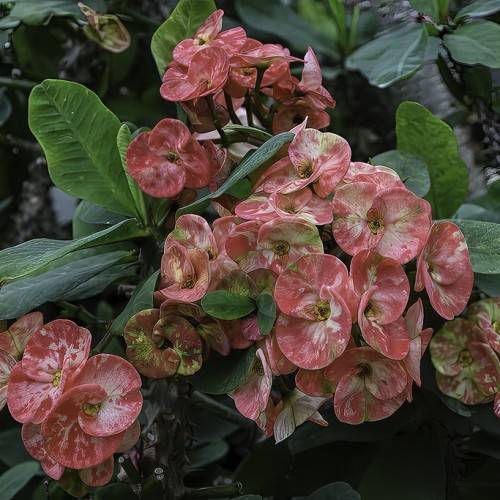
crown of thorns
Euphorbia milii (incl. hybrids)
Cycle:
Perennial
Watering:
Minimum
Hardiness Zone:
10
Flowers:
Flowers In Winter
Sun:
full sun,part shade
Soil:
Well-drained
Fruits:
Fruits Ready In
Growth Rate:
Low
Maintenance:
Moderate
Poisonous To Humans:
Yes
Poisonous To Pets:
Yes
Drought Tolerant:
Yes
Salt Tolerant:
Yes
Thorny:
Yes
Invasive:
Yes
Tropical:
Yes
Indoors:
Yes
watering
Crown of thorns plants need to be watered regularly to keep them healthy and in bloom, but they don't require a lot of water. Water when the soil feels dry to the touch, usually every 5 to 7 days, and make sure to avoid overwatering. Allow the soil to dry out between waterings, as crown of thorns plants can suffer from root rot if their soil is wet for prolonged periods of time. During the summer, water more frequently - every 2 to 3 days - unless the plant is in a very humid environment. During the winter, decrease the frequency of watering, and let the soil dry out a bit more between each watering.
sunlight
Crown of thorns requires bright, direct sunlight most of the day to help them maintain their vibrant colors and to encourage healthy growth. A minimum of 4–5 hours of direct sunlight is recommended daily, but plants may thrive with up to 8 hours of direct sunlight per day. During the summer months, they should receive full sun all day, while in winter they should be protected from the harshest rays of the sun in the middle of the day by providing some shade, such as a nearby tree or shrub. Avoiding too much indirect sunlight can help them avoid becoming leggy and weak.
pruning
When pruning crown of thorns (Euphorbia milii incl. hybrids) plants, it is important to begin pruning as soon as the plant is established. Early pruning is important to ensure that your plant is healthy, as this helps to control its size while encouraging it to develop branches and shrub-like growth. Pruning should be done once or twice a year, with a major prune scheduled for late in the season when the plant is beginning to prepare for dormancy. During this major prune, it is helpful to cut back any straggly or overly vigorous stems as well as any dead growth. Pruning should be done about a third of the way back on the stems, allowing for some leaves to remain.
